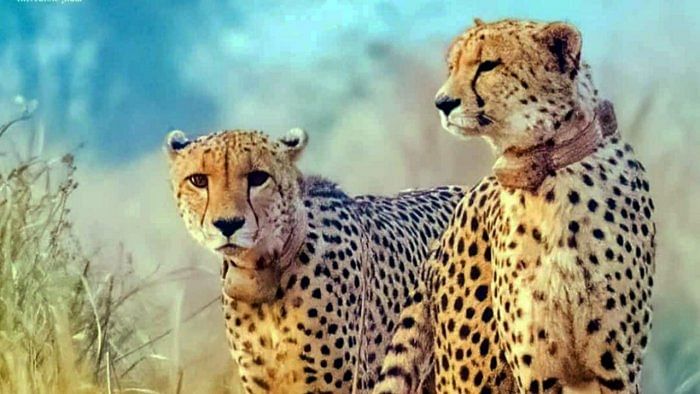
The natural process of cheetahs developing thick coats of fur in anticipation of African winter appears to be proving fatal in India's wet and hot conditions, international experts involved in the Project Cheetah have said.
In a report to the government, they suggested interventions such as shaving off the winter coats to deal with fatal infections and prevent any more death. Six of the 20 adult cheetahs relocated to the Kuno National Park in Madhya Pradesh from Africa have died since March this year -- the latest being on Wednesday.
The experts said that the thicker coats, high parasite load and moisture create a perfect recipe for dermatitis with fly strike on top of it compounding the infection and compromising the skin's integrity.
Infections can spread and the contaminated fluids can run down the spine when the cheetahs sit up on their haunches, they said.
A government official associated with the project said that not all the felines have developed thicker coats.
"Some of these cheetahs who do not have long hair are not facing such issues. So it's natural selection. The fittest of them and their offsprings will survive and thrive in the Indian conditions," the official said on condition of anonymity.
In their report submitted to the government recently, the experts said that adapting on an "evolutionary timescale" might be the only permanent solution if there's a genetic link to the development of winter coats.
However, the report notes that the climate itself is not a significant limiting factor for cheetahs as their historical range extends from southern Russia to South Africa, overlapping with various climatic zones.
Data from 364 metapopulation relocations between 2011 and 2022 also indicate that climate is not a major hindrance to cheetah survival, according to the research cited in the report.
The government official quoted above acknowledged that even the African experts had not anticipated such a situation.
"Some of these cheetahs who do not have long hair are not facing such issues. So it's natural selection. The fittest of them and their offsprings will survive and thrive in the Indian conditions," he said.
The experts suggest interventions such as shaving off the winter coats to deal with the issue and prevent more deaths.
However, there are concerns about the potential risks of administering medicine, involving darting, capturing, and returning the cheetahs to enclosures. Such actions may lead to stress and mortality risks, impacting the cheetahs' adjustment to their new habitat.
Research shows cheetah immobilisation carries a high risk of mortality and the extreme stress prevents the cheetahs from settling into their new habitat.
Ravi Chellam, wildlife expert and coordinator of Biodiversity Collaborative, Bengaluru, called for stopping the import of more cheetahs, considering the challenges faced in India.
Last month, two South African male cheetahs -- Tejas and Suraj -- died due to infection in wounds caused by the radio collars around their necks. However, the environment ministry said all cheetah deaths were due to natural causes.
Three Namibian male cheetahs -- Pawan, Gaurav, and Shaurya -- and two females -- Aasha and Savannah -- were subsequently found having similar skin infections.
An expert veterinarian from South Africa cleaned up the wounds. All the cheetahs have been administered Fluralaner, a systemic insecticide and acaricide given orally or topically.
There could be a need to repeat the treatment before the monsoon season next year to reduce parasite loads until the animals develop a sufficient level of immunity, the experts said.
Under the much-vaunted Project Cheetah, a total of 20 animals were imported from Namibia and South Africa to the KNP in two batches -- one in September last year and the second in February this year.
Since March, six of these adult cheetahs have died due to various reasons. In May, three of the four cubs born to a female Namibian cheetah had also succumbed to extreme heat. The remaining cub is being hand-raised for future wildling.